|
How to make a herbarium voucher
The most common type of herbarium voucher is a pressed,
dried plant specimen attached to a sheet of paper. The addition of a
label containing information on the plant's location, habitat type,
date of collection and name of collector completes the voucher. Presses
for the drying of herbarium specimens can be purchased from a variety
of biological suppliers, but a simple press can be made inexpensively.
The following images demonstrate a common method by which herbarium
vouchers are pressed and dried. Click on an image for a larger view.
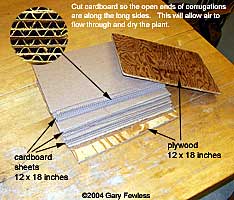 |
A simple press consists of 2 pieces of plywood and
several pieces of cardboard, each of size 12 x 18 inches |
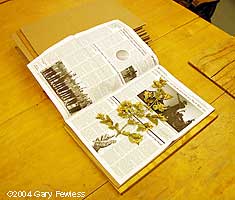 |
Place one piece of cardboard on one of the pieces
of plywood. Place one open sheet of newspaper on the cardboard and
lay out the plant to be pressed. You may need to cut the newspaper
to size. Take care to spread out the plant--once it is dry you will
not be able to turn over or unfold the leaves. The dried plant will
be glued to a sheet of paper later, so it is a good idea to turn
over at least one leaf before drying so that an observer can see
examples of both top and bottom of leaves after they are glued down. |
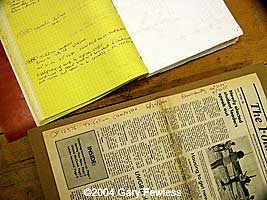 |
Close the newspaper over the plant and check that
you have identified the specimen. Typically each specimen is assigned
a collector number in a notebook and that number is written on the
newspaper in which the plant is pressed. More thorough information
is recorded in the notebook for inclusion on the label that will
accompany the voucher. |
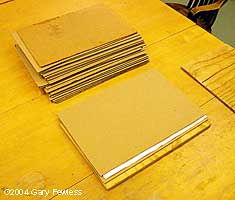 |
Cover the newspaper with another piece of cardboard. Then lay
another sheet of open newspaper on the cardboard, lay out another
plant, close the paper, add another cardboard, etc. until all
plants have been processed.
|
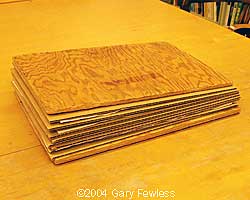 |
Place the second piece of plywood on
top of the stack. |
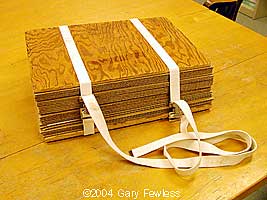 |
Use the straps to draw the stack of plywood and cardboard
tight. |
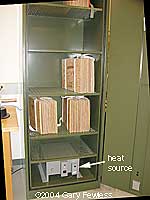 |
Place the press on edge over a heat source. Warm air rising through
the holes in the cardboard will dry the plants. Once they are
dry they will not decompose and they will not change shape. Any
heat source can be used, keeping safety in mind. Obviously open
flames are not an acceptable heat source.
|
| Typically, collectors press the plants in newspaper.
Some local "shopper" newspapers, etc may be nearly the
correct size for this purpose. Regular newspapers can be cut to about
16 x 11 inches. The plants must fit in this size because they must
fit on a standard sized sheet of paper in the collection . Specimens
collected for vouchers must include plants or plant parts sufficient
to reliably identify the voucher. For many plants that will require
flowers and/or fruit, but for trees it is often possible to make
a good voucher from mature leaves attached to a twig -- winter buds
are also helpful and will be fully formed by mid to late July and
extending throughout the next winter. September is a very good time
to collect vouchers of many deciduous trees. As you gain experience
in identifying the plants, you will learn what characters are necessary
to identify them, and can therefore collect the vouchers accordingly.
Many collectors choose to assign a unique collector number to
each specimen, usually beginning with 1, 2, 3 etc. and continuing
for their entire career. The number can then be used in your field
notes to keep track of the data pertaining to each voucher, and
that same number can be written on the newspaper in which the
plant is pressed to keep the specimen connected to the information.
Taking and keeping good field notes is essential for those working
in natural resources fields. It has been my experience that the
information may also be important years later and for purposes
not initially intended.
Most herbaria prefer to mount the vouchers themselves. We use
a special kind of paper that is designed to last for a very long
time and to resist changes in color and consistency of the paper.
The glue is also chosen specifically for the making of herbarium
vouchers and we print labels on archive-quality paper with permanent
ink. Our preferred method is to receive each pressed and dried
plant in the newspaper it was dried in, with the label or the
label information on a separate sheet inside the newspaper. Fifteen
or twenty such sheets can be stacked, and then sandwiched between
two pieces of heavy cardboard and snuggly wrapped and tied with
string, or by taping the edges of the cardboard securely together
to hold the plants firmly and keep any parts from falling out.
They can be mailed in this fashion, with several bundles together
in a box if the number of plants is larger.
|
|

